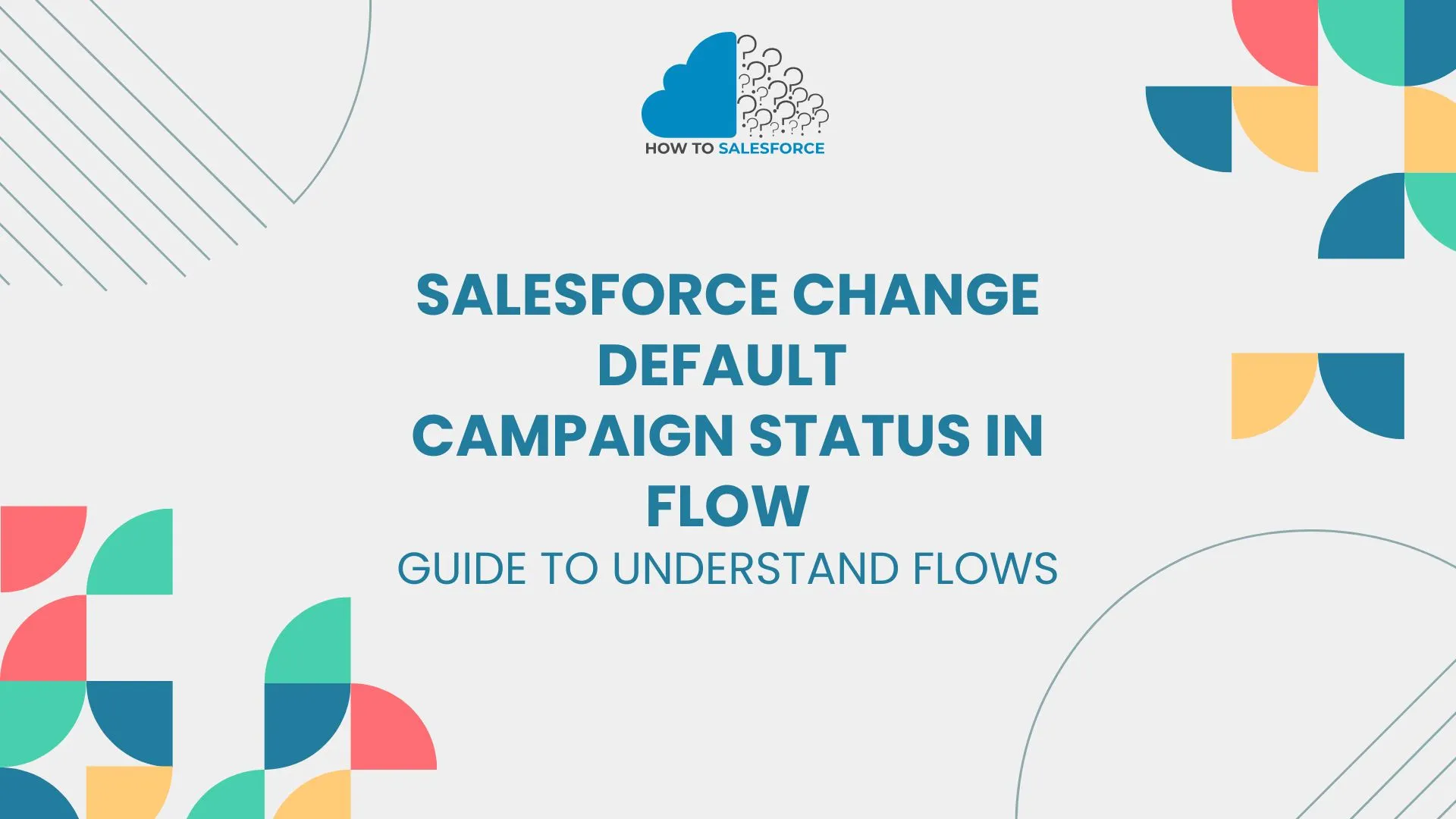Salesforce administrators often change campaign statuses to follow business rules. To improve reporting and campaign management, change the flow’s default campaign state. This blog post discusses Salesforce change default campaign status in the flow and provides a detailed how-to.
Please read my other blog: Salesforce Set Custom Permissions in Flow
Why Change Default Campaign Status in Salesforce
Firstly, Campaigns from Salesforce make it easier to monitor marketing initiatives and customer interaction. Nevertheless, not all organizations may require default campaign statuses like Sent or Responded. Customizing these statuses helps you match campaign management objectives.
Here are some justifications for why it’s imperative to modify the default campaign status.
- Align Campaigns with Strategy: Actual campaign stages in your company might not be reflected in default statuses.
- Improve Reporting: Precise statuses facilitate enhanced data analysis and segmentation.
- Enhance Efficiency: Hand labor is reduced by streamlining the process with customized statuses.
We will examine how to implement these changes within Salesforce flows while keeping these advantages in mind.
Understanding Campaign Status in Salesforce
Secondly, Campaign statuses in Salesforce serve as a visual representation of a campaign’s various phases or reactions. Although “Sent” and “Responded” are the default statuses, you can change them to better fit your marketing campaigns.
The campaign status can be updated manually or automatically with flows. Using flows to automate processes can save time and guarantee consistency. You can automate these updates by setting the default campaign status in a flow and basing it on specific triggers or conditions.
Commonly Used Campaign Statuses
Although every organization is different, the following campaign statuses are frequently seen.
- Invited: for webinars or events.
- Enumerated: Monitoring RSVPs for a function.
- Opened: Tracking the opening of emails.
- Clicked: Monitoring links that are clicked from emails.
- Attended: Indicates attendance at events.
Making statuses unique guarantees that they are significant and useful for your company.
Steps to Change Default Campaign Status in Flow
Moreover, Having grasped the significance of personalizing campaign statuses, let’s proceed to the detailed procedure of Salesforce to modify the default campaign status in flow. To effectively automate your campaign status updates, adhere to this guide.
Navigate to Salesforce Setup: Salesforce Change Default Campaign Status in Flow
To begin with, sign into Salesforce and select the Setup menu:
- – In the upper right corner, click the Gear Icon.
- – From the dropdown menu, choose Setup.
This will allow you to access all of your Salesforce org’s configurations through the Setup interface.
Access Flow Builder
Use the Quick Find box in Setup to look for Flows:
- – Under Process Automation, select Flows.
- – To start a new flow, click New Flow after that.
Choose the type of flow that best suits your requirements. For this guide, we suggest selecting a Record-Triggered Flow to modify the campaign status automatically upon fulfillment of specific requirements.
Define the Trigger: Salesforce Change Default Campaign Status in Flow
You need to specify when a record-triggered flow should be triggered.
- – Select the Campaign Member object, since the campaign status pertains to the campaign’s members.
- – Depending on your needs, set the flow to start when a record is created or updated.
Add Conditions for Campaign Status Update
Additionally, The next step is to establish the criteria that will help you decide when to modify the default campaign status:
- – To create conditions based on field values, use the Decision Element. For example, once you have sent an email, you may want to change its status to “Sent”.
- – Establish conditions in line with the steps of your campaign. For example, the status could change to Attended automatically if a campaign member attended an event.
Set the Default Campaign Status: Salesforce Change Default Campaign Status in Flow
Configure the flow to alter the campaign’s default state after you’ve established the conditions:
- – Include a section for updating records.
- – Select the object for the campaign member.
- – Choose Status from the list of fields to update.
- – Select the new default campaign status (Sent, Registered, Attended, etc.) that will be applied based on your condition.
Save and Activate the Flow
Save the flow after configuring the campaign status updates:
- – Name your flow something meaningful. Change the status of the campaign.
- – To make sure the flow is operational, click Activate.
Test the Flow
It is now necessary to test the flow. To check if the logic of the flow modifies the default campaign status, go to a campaign and add or modify a campaign member.
- – Launch a test marketing effort.
- – Include a supporter of the campaign.
Moreover, Check to see if the flow updates the state automatically according to its conditions.
You can implement the flow into your marketing operations if everything goes according to plan.
Best Practices for Managing Campaign Status in Salesforce Flows
These best practices apply to changing the default campaign status in Salesforce to maintain the seamless functioning of your flows:
Keep Statuses Simple and Clear
Avoid giving your team too many status updates. Make sure you use language that is easy for everyone to understand. Remain focused on doable actions that enhance reporting and decision-making.
Automate Regular Updates: Salesforce Change Default Campaign Status in Flow
In order to take advantage of automation. Manually updating the campaign status regularly may result in mistakes. Automating these updates through flows saves time and preserves data integrity.
Monitor Campaign Performance
Regularly monitor and assess campaign performance. With custom statuses, you can keep an eye on particular campaign stages and base decisions on reliable information.
Document Your Process
Additionally, Make sure everyone on your team is aware of the modifications made to the campaign’s default status. Share the flow process documentation with the appropriate parties. Appropriate documentation ensures consistency within the company.
Consider Flow Limitations
Although Salesforce flows are strong, they are not without limitations. Performance may be impacted by complicated logic and the quantity of flow executions. Before putting your flow into production, make sure it passes in a sandbox.
The Impact of Changing Campaign Status
Later Changing the Salesforce default campaign status has a big effect on how your business monitors and controls campaigns. This is how it can have an impact:
Improved Accuracy in Reporting
More accurate data results from customized campaign statuses. Customized, meaningful status updates improve campaign reporting. It is simple to monitor the success of campaigns and pinpoint areas that require development.
Enhanced Collaboration
Afterward, Collaboration is facilitated by transparent and automatically updated campaign statuses. Teams don’t need to constantly receive updates to monitor the status of campaigns. When concentrating on lead conversion, sales and marketing can collaborate effectively.
Increased Efficiency: Salesforce Change Default Campaign Status in Flow
Furthermore, using flows to automate campaign status updates can save time. With the elimination of the need for manual status tracking, teams can now concentrate on higher-value tasks. This effectiveness improves campaign management as a whole.
Better Customer Experience
Moreover, Clear campaign statuses help your teams interact with customers more successfully. Knowing a lead’s stage allows for more individualized communication, which improves the customer experience.
Conclusion
Changes to the default campaign status are one of the most essential Salesforce flow adjustments for marketing teams. It improves reporting, automates processes, and aligns campaigns with company goals. This post shows how to change the Salesforce default campaign status in flow.
Automating campaign status updates improves operational effectiveness and guarantees data accuracy. Additionally, it makes it possible for your sales and marketing teams to work together more successfully, which enhances campaign performance overall and yields better results.


